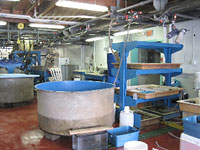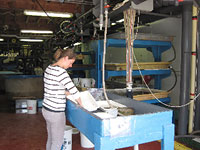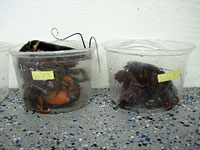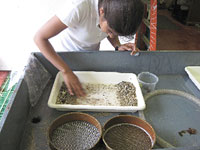

 | |||||||||||||||||||
|
|
Journals 2009/2010Jennifer Emblidge
August 10, 2009 Bright and early this morning I walked down to Rick Wahle's lab to find most of his lab already busy starting their work. Rick's lab is a very hopping place with many individuals involved in some aspect of his work. I have decided that I will introduce you to one individual per day so you can fully appreciate just how many scientists I was able to meet during my stay.
My day began by getting a formal tour of the places in the Darling Marine Center that involve any aspect of Rick's daily work. Lee Reeve was kind enough to take me on this tour. Today I will introduce you to Lee. She is a post undergraduate student who is helping Rick's lab with their ongoing Lobster Settlement project. She has been working in his lab since this past May and will stay until November. She will then be applying for graduate schools in marine biology. Lee is possibly looking to work within the realm of fisheries ecology. I asked Lee what her favorite part of her job was. Lee replied that she enjoyed the diving she gets to do and she particularly liked being able to see how the samples she picked up during her diving related to the actual sample sorting she does in the lab. Lee also piped in that she thought it was fun to be a part of a lab with so many projects and scientists that were all working on a separate piece of the puzzle that they were hoping to solve together. When I asked Lee what her least favorite part of the job was she couldn't even think of a bad part...now that's great if you ask me! Lee really enjoys this part of Maine because she is able find many beautiful locations to go sailing and hiking without having to travel far. The first stop on my tour was the Flowing Seawater Lab. Here is where a lot of experiments are run because there are many different tanks available and fresh seawater pumped in. It is Lee's job to monitor and feed the young lobsters they are rearing in this area. They are attempting to raise the baby lobsters to a developmental stage in their life cycle that will allow for successful recruitment when they are released into the bay. They raise the lobsters to what is called a stage 5, developmental stage. It is at this point that the lobsters are ready to settle and have stopped exploring the ocean bottom. There were also some tanks holding scallops, crabs and snails.
The next stop was to the Mitchell Building. This building holds the algae cultures that are used to feed the scallops and it also contains the classroom where the lab holds their weekly meeting to update one another on what is occurring in the lab. Next we visited the dive locker. This is the area that Rick's lab uses to hold all of their diving equipment. It was full of tanks and SCUBA gear. The last stop on the tour was out to the dock that extends into the Bay. The lab is located upstream from the area where the Damariscota River meets the ocean. From the dock, Lee pointed on the Ira C which is the Darling Marine Center's research vessel and the two smaller boats that are used by their lab when they go diving. At the conclusion of the tour, Lee put me straight to work. Today I helped sort bottom quadrate samples that were taken from Penobscot Bay which is located to the north in Stonington, ME. The lab samples a total of eight sites for this project. Four of the sites are from East Stonington and four sites are from West Stonington. Two of the four sites are sample sites and two sites are control sites. The samples are used to help determine the success of the lobster hatchery in Penobscot Bay. Today, we were sorting through the samples to find lobsters, crabs, and fish. The lobsters are collected and their length and sex are recorded. Tissue samples are also taken from each lobster and recorded. The fish and crab data includes species and size. Why are fish and crabs if this is a lobster project you may ask? Good question! I asked the same one! They prey on lobsters so they will be used to give us a better picture of the predation rate on lobsters in Penobscot Bay. The genetic work on the lobster tissue samples will be used to help determine if the collected lobsters were from the hatchery or not. Rick's lab is trying to determine if the lobster hatchery will be successful at replenishing the diminishing lobster population in Penobscot Bay.
At 11 a.m. the whole lab took a break and stopped whatever they were working on. We all met in the upper campus conference room where we were able to use the Polycom to see and hear Rick's presentation at the University of Maine campus in Orono. I learned a lot about Rick's ongoing projects during this presentation and so as not to overwhelm all of you, I will inform you about bits and pieces of his work during each journal entry so you can get a sense of the entirety and complexity of his work when I am finished here. I spent the rest of the day sorting sample with Lee. We were joined by another graduate student in Rick's lab, named Mahima Jaini. You will get to hear all about her another day! Sorting bottom samples is not tricky. All you need is a sieve and some seawater and you are good to go. First, you dump the sample into the sieve. Next, you use the hose to run the water through the sieve. The sieve is like a metal basket. The smaller bottom pieces (mostly sediment) will run through the sieve with the water and the larger pieces remain. You then dump the larger pieces into a bin and slowly use your eyes to sort through the pieces. The samples consisted of a lot of rocks, shells, algae and worms. Very few lobsters, crabs or fish were found in each sample. However, if they were found, they were separated out to be measured, and recorded later on.
|
||||||||||||||||||




